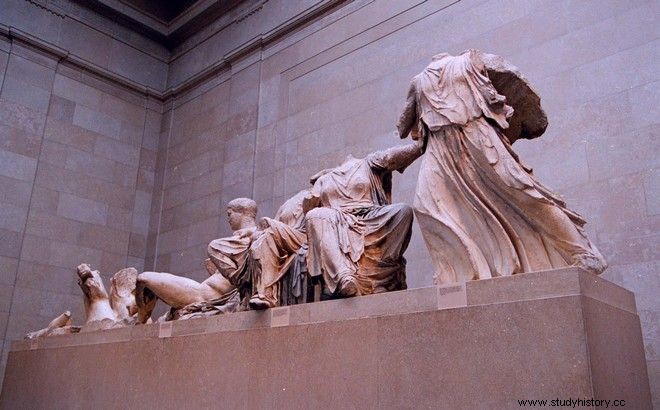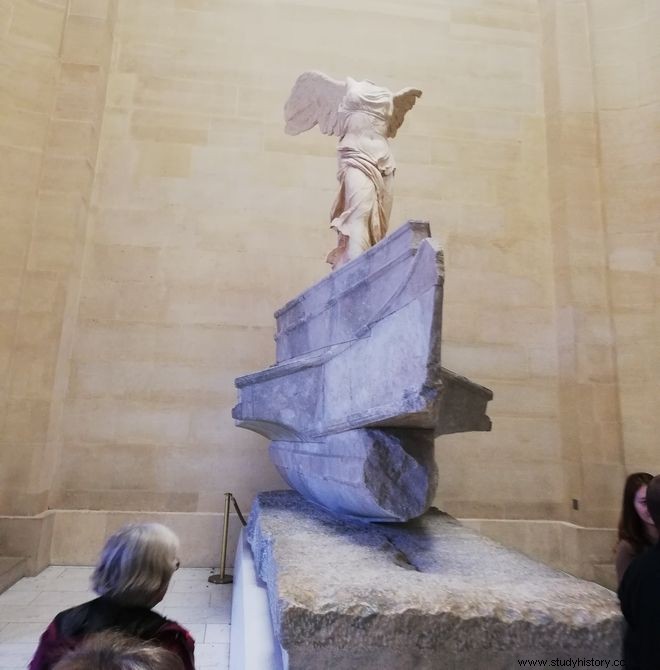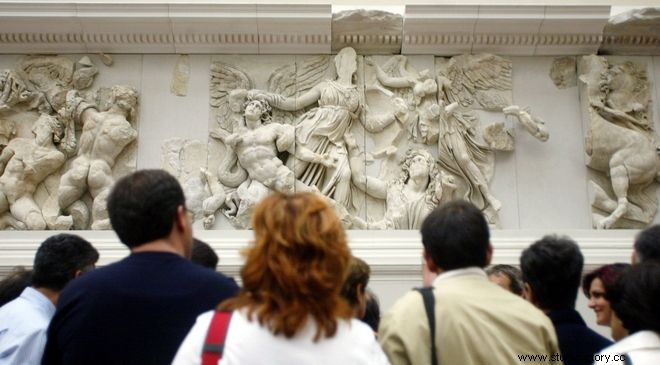A large part of the culture of ancient Greece was literally plundered by various conquerors and travelers over the centuries, and so today many Greek works of art are scattered in museums of the world, and not in the place where they were "born".
The prevalence of Christianity and the destabilization of "paganism", the fall of Byzantium and the subsequent Turkish rule, but above all the lack of national consciousness and national idea until the first independence of the modern Greek state, contributed to the absence of a legal framework for these antiquities .
The first reactions to the Greek "stolen" arose after the looting of Elgin. As the director of research of the National Research Foundation and historian Giorgos Tolias observed at the presentation of the documentary "The Call of the Marbles", produced by COSMOTE TV:"The intense reactions around this issue arose because of the brutality of the Elgin movement. Up to that time we had never seen the demolition or destruction of monuments. It is quite another thing to collect scattered antiquities and gather them together to study them, and quite another thing to destroy monuments in order to remove from them the sculptural decoration or what one considers treasure.That is, to plunder monuments that everyone knew about and no one knew about. was teasing for the purpose of personal promotion or profit".
As William St Clair states in the series , historian at the Institute of English Studies at the University of London:
"If you walk around London today, you will find little Parthenons, little Erechtheia and little Propylaea. Not only in London, but in Edinburgh, Bath and elsewhere. There is an aesthetic, and the aesthetic is not about beauty, but about perfection. When you come in contact with the perfect, as the Ancients said, you are "approved" as a human being, you acquire education. But when this transfer is made in a modern country, education is lost and ends up becoming a decorative element".
This harmony, the aesthetic perfection that the ancient Greek monuments exude, combined with the value they carry, are also the reasons why they attract so many eyes. Their timelessness makes them central exhibits in the world's largest museums. In the Louvre, the Victory of Samothrace and the Venus of Milos stand in the most prominent positions and are a "favorite" attraction for visitors.
And as Mr. Tolias observed, it is so difficult for the British to decide to return Elginia, as without them the London museum will lose most of its glory.
However, this ancient Greek glamor was universalized over the centuries. As the director of the documentary, Kleanthis Danopoulos, observed:
"The series presents the defining points of the relationship between Western Civilization and the works of Greek antiquity, over the last five centuries. This relationship, which continues unbroken from the Renaissance to the present day, largely defines the course of development of the West of Culture, while it played a decisive role in the creation and shaping of the Greek state. The objects that have been transferred to most museums in Europe are a sample of this relationship".
"During this period, Western civilization defined itself as a continuation of the spirit and aesthetics of Greek Antiquity, which creates a special case in world history. Manuscripts, coins and a large number of works of art were transferred from Greece to Western Europe, decisively influencing the art and intellectual pursuits of Europe. The great capitals of the Western world were adorned with buildings referencing the Classical culture, while the arts developed based on the standards and pursuits of Greek Antiquity. Therefore, the interest in the series is not only the looting, but the fact that after the Renaissance Western Europe assimilated many elements from the ancient Greek culture".
This assimilation is reflected in the way ancient Greek finds are included and highlighted through their museum presentation in Europe and beyond. However, the claims of the Elginians, carry within them the just demand for the restoration of a brutal mutilation of an active - since that time - monument. Other antiquities were periodically recovered from areas that are not part of today's "Greek space" but are inextricably linked to the history of Ancient Greece.
The marbles of the Parthenon they were detached from 1799 to 1803, and transferred to Britain in 1806, a few years before the Greek revolution and the establishment of the Greek state, which was built around association with ancient heritage. Also, Elgin is charged with the destruction of a monument of world significance, which without the removed marbles, stands wanting in its grandeur.
Since 1983, on the initiative of the then Minister of Culture, Melina Merkouris, Greece has been making efforts to bring the sculptures back to Athens, while UNESCO is supporting the claims based on the principle of preserving the integrity of the monuments of world cultural heritage.
In 2009, the British Museum stated that, on the occasion of the opening of the New Acropolis Museum, it would be willing to lend the Sculptures, as long as the Greek government recognized their right of ownership to the Museum. The Greek government rejected the proposal.
Parthenon marbles
The collection of sculptures in question includes some of the sculptures of the pediments, the metopes, which depict battles between the Lapiths and the Centaurs, but also the Parthenon frieze that adorned the upper part of the nave walls of the temple along their entire length.
As such, they represent more than 1/2 of what remains of the sculptural decoration of the Parthenon that survived:75 meters of the original 160 meters, 15 of the 92 metopes, 17 segmental figures from the pediments, as well as other parts of architecture. Elgin's holdings also include items from other buildings on the Athenian Acropolis:the Erechtheion, reduced to ruins during the Greek War of Independence (1821-33), the Propylaia and the Temple of Athena Nike. Lord Elgin took about half of the Parthenon sculptures and plaster casts were made of the rest. Since then Marmara is often referred to as Elginia.

One of the returned Parthenon marbles is the Palermo Section. It is a 2,500-year-old marble sculpture of the foot and dress of the goddess Artemis.
This section was removed by Lord Elgin in the early 19th century and handed over to the British Consul in Sicily in 1816.
During the last two centuries, this section was kept in the Archaeological Museum of Salinas in Palermo.
Greece's 13-year effort to return the section was completed on September 24, 2008, when Italian President Giorgio Napolitano brought this marble to Athens.
It was thought that this move would strengthen Greece's position in its attempt to bring back the remaining marbles from the British Museum.

Aphrodite of Milos
The Venus of Milos is a well-known marble statue of the late Hellenistic - early Roman era (around 150 - 50 BC), which was found in the spring of 1820, in a rural area of Milos. The statue was found in over 6 separate pieces and ended up a year later in the Louvre Museum, where it is still on display.
In the museum of Milos there is a faithful copy of it, which was sent by the Louvre as a donation.
It is considered a landmark work of Hellenistic art, which harmoniously combines female beauty and femininity. It was considered the work of Praxiteles, but today it is clear that the creator is someone else. It is one of the most important acquisitions of the Louvre.
She was found mutilated and it is assumed that the goddess was holding an apple or a mirror in her left hand or that she was holding the shield of Mars with both hands. There is a legend about her hands that they broke during a fight between French archaeologists and Greeks during the transfer of the statue.

The adventure of detaching the statue:
According to sansimera.gr, the statue had an adventurous journey until it reached the Louvre Museum. It was discovered when the hoe of the farmer Georgios Kentrotas, who was cultivating his field, hit a stone underground vault, under which the statue was placed.
Kentrotas, when he recovered from the surprise, took the precious find and hid it with all secrecy in his house.
But the secret quickly became known and reached the ears of both the consular agent of France in Constantinople and the prefects of Athens. The first informed the Greek-learned and antiquarian ensign D'Urville, a member of the crew of a French warship sailing in Constantinople.
D'Urville hastened to Milos and visited Kentrota's house. Such was his admiration for the statue that he immediately returned to Constantinople and informed the French ambassador of its value. He ordered the warship to head for Milos and take it at all costs.
Meanwhile, the prefects of Athens sent the priest Vergis to the island in a Turkish ship with orders to take the precious find to Athens. Vergis arrived in Milos and convinced the locals and the Turkish authorities to hand over the statue to him. He packed it in a wooden box and was about to load the ship when, unfortunately for him, the French arrived.
At gunpoint, the French sailors wrested the precious cargo from the hands of the Greeks and Turks and transferred it to the warship, which immediately headed for France.
The Victory of Samothrace
It is a marble sculpture by an unknown artist of the Hellenistic era that was found in the sanctuary of the Great Gods in Samothrace and represents the winged Goddess Nike.
The sculpture has been exhibited in the Louvre Museum since 1884. It is one of the three winged Nikes found in the Temple of Samothrace. The other two are on display - the first, which is a Roman copy and was found by Austrian archaeologists - at the Kunsthistorisches Museum in Vienna and the second, found by the American expedition of Karl Lehmann and Phyllis Williams-Lehmann in 1949, at the Archaeological Museum of Samothrace.

The goddess was carved separately from white Parian marble and may have held a victor's wreath or raised her hand to her mouth to proclaim victory without holding anything or saluting.
The statue in the Hellenistic complex was attached to the also marble prow of a ship and gave the impression that it had just "landed" on it and was treading fleetingly. The ship was made of Rhodes marble (the grayish marble of Lindos, specifically Lardos). Experts have speculated that the work was designed to be viewed from the left, in ¾ profile, because one side is more well-made – and in Hellenistic times this was customary for the side the public would see.

One version of the archaeologists for the dedication was that Demetrius the Besieger (337-283 BC) had done it when he defeated Ptolemy's fleet off Cyprus around 290 BC. But today many believe that it was dedicated by the Rhodians when in 191 BC, in alliance with Pergamum, they defeated Antiochus III of Syria in a naval battle off Sidis.
The pieces of the sculpture were found piecemeal and at first Nike was exhibited in the Louvre without her torso and wings but also without her bow, the pieces of which the French experts had at first assumed belonged to a mound and had left them in Samothrace.
In particular, the discovery began in 1863 by an archaeological expedition headed by Charles Champoiseau (1830-1909), vice consul of France in Adrianople.
From the Greek side, various movements and efforts have been made to return the Victory of Samothrace to Greece, but this was not possible.
Aphrodite of Taurida
It is located in the Hermitage Museum in St. Petersburg. This statue was made in the 3rd or 2nd BC. century and is a copy of the famous work of Praxiteles, Cnidia Aphrodite (4th BC). During Hellenistic and Roman times, it was copied more than any other sculpture. Acquired in 1719 from the market of Rome for 200 silver coins from Potemkin on behalf of Peter the Great.
The museum in question gathers 30,000 Greek antiquities, out of the 100,000 antiquities it gathers in total in its exhibits.
The Discus Thrower of Myron
The Diskovolos, a bronze work by the sculptor Myron, dates back to around 450 BC. and is one of the first works in the history of art to depict the athlete in a momentary pose (snapshot, instant). Here we are not talking about some "stolen" ancient Greek work, but about an emblematic work that was lost forever.
Although the original work is not preserved, the marble Roman copies that have survived to the present day - with the most faithful one of the so-called "Lancelloti discus thrower" - combined with Lucian's description, have led scholars to identify the copies with the bronze original of of classical times.
A copy of Myron's discus is now in the Vatican Museum and Naucydes' discus is in the British Museum.
The athlete is represented at the moment when he concentrates all his forces in the execution of the shot. Leans strongly forward, turning the torso and head to the right, while at the same time bending the knees. His right foot is firmly planted on the ground, while his left foot is barely supported, with the soles facing out. His right hand, which carries the disk, is extended backwards, while in order to balance his body, the athlete brings his left hand towards the knee.
The overall posture of his body testifies to the tension of the moment, which is reflected in his bulging veins and strong muscles. Instead, his face remains serene, emphasizing the discus thrower's self-concentration to achieve the best possible throw.
The structure of the statue is also impressive:the upper part turns to the left with the head and the lower to the right, in a centripetal-centrifugal movement.
Myron's discus thrower is the result of a careful study of the human body and touches on realism. However, if we exclude its free movement, the work still retains some archaic remains, such as the fact that it is not prominent, but two-dimensional, with the main view being the front. The tree trunk, where the athlete rests, was absent from the original, and is an addition of the replicas for static reasons.
Metropolitan Museum of New York (MET)
The Greco-Roman section of the museum was inaugurated in 1909 and includes more than 35,000 works of art.
Works from the Cycladic art collection are on display, such as the "Harper", the "Masterpiece of Basti", the "Warrior and Centaur Complex" and many others.

The collection of exhibits of ancient Greek art includes the most important examples of the Cycladic, Minoan, Mycenaean, Geometric, Archaic and Classical periods and is one of the richest in the world.
Wounded Amazon
The "Wounded Amazon" relief, which dates from around the 4th BC. century and was found in the excavations of Ephesus, it is in the Austrian museum in the center of Vienna.
Pergamon Museum in Berlin
The Altar of Pergamon is an altar dedicated to Zeus and Athena that was built in the Hellenistic era on the acropolis of Pergamon in Asia Minor. It was discovered by German archaeologists in excavations in Asia Minor around 1880 and brought to Berlin to be rebuilt in its original form.
It was part of a larger architectural complex, a model of which is also on display in the museum.
Directly across from the Altar of Pergamon are pieces of the battleship with the theme of the Battle of the Titans.

Watch the first episode - "The Awakening of Antiquity":
Contributors:
Production: COSMOTE TV
Production Execution Company: BOO Productions
Producer:Takis Nikolakopoulos
Script-Direction: Kleanthis Danopoulos
Photo credit: Ευγένιος Διονυσόπουλος
Επιστημονικοί σύμβουλοι: Μαίρη Αδαμοπούλου, Μαρίνος Αργυριάδης-Καχρίλας
Έρευνα αρχειακού υλικού: Μαρίνος Αργυριάδης – Καχρίλας
Επιμέλεια συνεντεύξεων: Μαίρη Αδαμοπούλου
Διεύθυνση παραγωγής: Πέτρος Μαντούβαλος, Ελένη Τσατσούλα
Αφήγηση: Γιώργος Λιάντος, Νίκος Τσινές
Μοντάζ: Θανάσης Παπαθανασίου, Μιχάλης Παπαδάκης
Βοηθοί σκηνοθέτη: Δημήτρης Παπαροϊδάμης, Ηλίας Στάθης
Συντονισμός παραγωγής: Βάσω Βασιλοπούλου, Κερασώ Ματιάτου, Χριστίνα Αναστοπούλου
Τα επεισόδια της νέας σειράς θα προβάλλονται σε Α’ προβολή στο COSMOTE HISTORY HD κάθε Τρίτη βράδυ στις 22.00 και σε επανάληψη κάθε Παρασκευή στις 19.00. Μετά την προβολή τους στο κανάλι, όλα τα επεισόδια θα είναι διαθέσιμα για δωρεάν on demand θέαση στην υπηρεσία COSMOTE TV PLUS.
